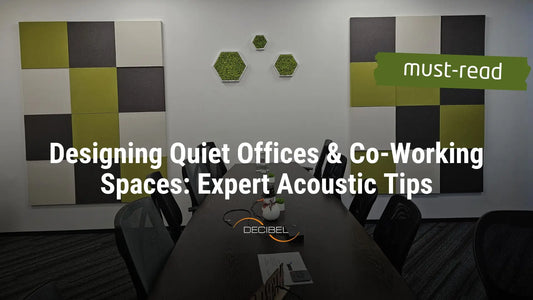
Why Soundproofing Matters in Modern Design
Ivan BerberovShare
📖 Reading time: 6 min and 28 sec
Can you tell a story about an invisible creeper that haunts your home or office building without it turning into a horror story? The entity is ruining your health and taking away your peace, mind you. You can hear footsteps, but no one other than you is at home, or an unidentified hum... You can even hear voices from the TV, while you made sure it's off before going to bed.
Is it a poltergeist or an evil spirit? And how can you fight it - holy water, a crucifix, salt on the doorframe? Who you gonna call?
Us. Because you need soundproofing. And when Velma pulls the mask off of this ghost's head, you will see that it was Noise all along. And it would have gotten away with it if it weren't for our meddling engineers.
Everyday Noise Is Worse Than You Think
Why does a person who does not follow sports know how the game ended last night? This is not the start of some joke. Any modern design, especially open-plan, needs to consider how the space will sound once there are people in, below or above it.
Noise travels farther and more easily than ever, the fewer walls there are. Lightweight construction materials, shared structural elements, and proximity to busy streets or other residents mean that unwanted sound is baked into the architecture.
Common Noisemakers in Residential and Office Settings
You don't even need to go looking - they usually find you first. Understanding the type of noise is the first step in soundproofing. Here’s what that often sounds like in practice:
- The low-frequency thump of footsteps from the floor above. Noise type: impact-borne.
- Late-night conversations or sounds from TV bleeding through shared walls. Noise type: airborne.
- Appliance buzz, plumbing noise, or humming ventilation units. Noise type: vibrational.
- Car horns, barking dogs, or the occasional motorbike tearing through the street at 2 AM. Noise type: Very annoying. Also airborne.

These intrusions chip away at your comfort and well-being. Poor sound insulation makes it harder to concentrate when working from home, to relax during your downtime, or to fall (and stay) asleep. Over time, this background noise becomes a source of stress, fatigue, and tension. As if you live with a creepy ghost.
That’s why proper soundproofing is about protecting your lifestyle, your routines, and your right to switch off.
The Psychology of Peace and Quiet
Noise, even quiet levels, can cause health problems if left unchecked long enough. Our brains are wired to stay alert to potential threats, which means that every footstep above, buzzing appliance, or muffled argument next door taxes your nervous system.
And sure, we can suppress or ignore it for a day or two, but how much is enough? Should it get to the level of an anxiety attack or restless sleep to notice it and do something about it?
Over time, this takes a toll:
- Stress levels rise, even when you’re not consciously bothered by the noise.
- Irritability increases, especially in shared living spaces or during work-from-home hours.
- Sleep quality declines as your brain struggles to stay in deep, restorative cycles.
- Cognitive performance drops, with reduced concentration and mental fatigue.
The result is cognitive overload: A state where your brain is processing too much, too often, without ever getting a break.
Soundproofing flips that dynamic. It creates mental space. A soundproofed home allows your mind to rest, your focus to sharpen, and your mood to stabilise. Quiet makes everything feel more intentional. Silence is a form of self-care.

Why Builders Should Prioritise Soundproofing from the Start
Soundproofing is easiest, most effective, and most affordable when considered at the design phase. This is a strategic advantage in a competitive property market.
Future-Proofed Comfort Begins in the Blueprint
Early-stage sound insulation allows architects and engineers to plan for proper wall mass, room separation, vibration isolation, and service decoupling before finishes are applied. This avoids expensive, invasive retrofits later on.
Incorporating systems like MUTE SYSTEM™ 23 or DECIBOARD™ into partition walls during framing ensures maximum performance with minimal disruption or extra labour. Ceiling solutions like C-MUTE SYSTEM™ 33 can be embedded before lighting or HVAC installations are finalised, avoiding clashes and saving hours of rework.
Financial Logic: Cheaper to Build It In Than Bolt It On
Installing soundproofing during construction can be up to 60% more cost-effective than retrofitting the same system post-build. That’s because labour is already on-site, materials are easier to integrate, and access is unobstructed. You’re not paying twice for demolition and reapplication of plasterboard, paint, or ceilings.
And because these systems also improve thermal insulation and reduce vibration transmission, they often contribute to lower lifecycle maintenance and enhanced energy efficiency. Further aligning with sustainability goals and reducing long-term costs.
Quiet Buildings Sell Better and Age Gracefully
Homes and offices built with acoustic comfort in mind tend to hold their value better and generate fewer complaints from occupants. Listings that mention soundproofing or "quiet interiors" sell faster and often command a premium.
In multi-unit buildings, sound isolation between flats is one of the most common post-sale grievances. You reduce the risk of warranty issues, refund claims, and negative reviews from new owners.

Differentiation That Can’t Be Copied Later
Finishes can be changed. Flooring can be upgraded. But the quiet solidity of a well-soundproofed building? That’s embedded into its bones.
For builders seeking long-term brand reputation and word-of-mouth value, this is one feature that quietly speaks volumes. Oh, you couldn't sleep because of elevator noise and barking dogs. Can't relate, I bought my apartment from a building company that cares - they use soundproofing.
Renovating? Add Soundproofing to the List
If done right, soundproofing is an invisible upgrade that pays off well into the future. It’s one of those improvements that’s cheaper and simpler to do mid-renovation, yet often overlooked. Even better in the early stages of construction, and luckily for them, some builders are indeed realising that.
Timing Is Everything
Once the plaster goes up and the paint dries, retrofitting sound insulation gets messy and expensive. During a renovation, you already have access to bare walls, ceilings, or flooring. Adding soundproofing at that stage is straightforward. You're not fighting against finished surfaces; you're integrating smart materials into the building itself.
In other words, soundproofing is much like insulation or wiring, best done while the structure is open. Retrofitting can get up to 60% more expensive with all the demolition and reconstruction of wall finishers.
Soundproofing: Smarter Long-Term Living
Noise complaints are one of the most common post-renovation issues. They could be triggered by several things, like the upstairs flat, a teenager’s music, or your own appliances echoing through the walls. Poor sound control reduces comfort and increases tension over time. No one wants to walk on eggshells or yell at neighbours instead of relaxing after a hard day's work.

By contrast, homes with effective noise insulation:
- Feel more private and peaceful, no matter the layout or location.
- Age better, with fewer cracks or maintenance calls caused by vibration-related wear.
- Hold higher value, especially in dense urban areas where quiet is a premium.
In fact, as more buyers start asking about soundproofing performance, having quiet zones built into the bones of your renovation can be a subtle but powerful selling point.
Where to Soundproof First and What to Use
Not every wall needs heavy-duty insulation. But certain areas of a home tend to collect noise like a dish antenna collects signals. Those are the zones where soundproofing delivers real comfort.
Prioritise the Spaces Where Silence Matters Most
Some rooms demand a bit more quiet than others. Most of the time, people in them aim at rest, focus, or just a bit of breathing space.
-
Bedrooms: Traffic, early-rising neighbours, or even your own appliances in the next room can wear down your sleep cycle over time.
-
Home offices: If your work requires focus, the sound of footsteps or TV chatter from another room can chip away at productivity.
-
Shared walls: In apartment blocks or terraced housing, a thin wall can mean you’re living part-time in your neighbour’s routine.
-
Ceilings: The soft thump of overhead movement is one of the hardest sounds to ignore, especially in multi-storey homes.
The Right Tool for the Right Surface
For walls that see typical household use like bedrooms, living rooms, and home studies, many renovators start with straightforward, clip-on wall panels. These reduce noise transmission without taking up much space or requiring structural changes. Some models even allow for minimal wall contact (under 3%), which helps block airborne noise more effectively. This approach is a good starting point for smart renters, small renovations, or lighter budgets.

Ceiling noise, especially footfall from above, needs a different approach. Here, panels that decouple from the ceiling using vibration-dampening connectors are far more effective. They work by interrupting the transmission path. But there is a tricky thing: If you want to stop the footfall noise from your upstairs neighbour, you will achieve better results if you isolate your neighbour's floor, rather than your ceiling. This, however, is rarely possible.
If you’re working with a long-term layout or remodelling more than one room, wall systems that rely on anti-vibration fasteners can offer better performance. These systems usually involve less than 1% surface contact between the panel and the wall, which dramatically lowers both airborne and structural noise.
A Few Systems Worth Knowing
If you're exploring options, DECIBOARD™ offers a tool-free, panel-based approach that's popular for its ease and compact profile. For ceiling control, C-MUTE SYSTEM™ brings a technical edge, using elastomer fasteners to target structure-borne noise.
And for deeper wall insulation in spaces like media rooms or nurseries, MUTE SYSTEM™ gives you the benefit of studio-grade isolation with a clean architectural finish.
Additional Reading & References:
-
Future Homes - Avoiding unintended consequences
-
DEFRA. (2013) Noise pollution: economic analysis
-
UK Green Building Council. (2021) Health and Wellbeing in Homes




